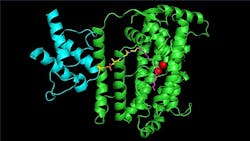A function found in a plant enzyme could inspire a new form of “green” chemistry, say researchers at the U.S. Department of Energy’s Brookhaven National Laboratory, Upton, N.Y. The diiron enzyme, which contains two iron atoms in its active state, surprised the researchers with its ability to transfer two oxygen atoms from a single O2 molecule during a reaction. The enzyme promotes a key chemical reaction needed to synthesize a wide array of organic molecules.
“Maybe we can adapt this biomolecule to make useful chemicals in plants, or use it as the basis for designing new bio-inspired catalysts to replace more expensive, toxic catalysts currently in use,” suggests Brookhaven Lab biochemist John Shanklin, who led the research.
These desaturase enzymes remove the hydrogen atoms in a hydrocarbon chain and insert a double bond between the carbon atoms. Studying a previously created triple mutant version of a desaturase enzyme, the researchers discovered two of the single mutant enzymes stripped the double bond between adjacent carbon atoms and added an OH (hydroxyl group) to each carbon to produce a fatty acid with two adjacent hydroxyl groups.
Fatty acids containing such adjacent OH groups, known as diols, are important components for making lubricants. They can also be converted to building blocks for making plastics or other commodity products. However, making them artificially in a lab is a challenge.
Figure 1. This desaturase enzyme introduces adjacent hydroxyl groups into a fatty acid can be used to synthesize a wide range of organic molecules. Source: Brookhaven National Laboratory.
The work could help the team learn how to control the configuration of lab-made catalysts to mimic the plant-derived version.
“If we can incorporate what we’ve learned into the design of industrial catalysts, those reactions could produce purer products with less waste and avoid using toxic chemicals,” notes Shanklin.
Elaborating further, he says, “Industrial catalysis commonly produce a mixture of enantiomers of diols. … The enzyme essentially makes a single enantiomer, and uses molecular oxygen and the diiron active site to perform the dioxygenase chemistry. Thus, if a catalyst could be created that employed a diiron site with similar geometry… then [it would rival] the currently employed process that makes several enantiomers which then have to be purified — and only one of them is a useful feedstock so the other has to be disposed. Also, current processes use harsh oxidants that can be toxic. From the plant enzyme we know the process can proceed at room temperature and without harsh oxidants, so we expect that biomimetic catalysists could be designed to do this under similar mild conditions.”
An article in Plant Physiology contains more detail.
The team next plans to obtain a crystal structure of this enzyme using x-rays. “We have purified sufficient quantities to perform crystallization trials on the mutant for which this chemistry is optimized. We anticipate using advanced crystallography beamlines to solve a crystal structure of this mutant within six months. We will then work with our computational colleagues to understand the details of the catalytic mechanism,” says Shanklin.
“Understanding such enzymes at the biological level through biochemical, structural and computational approaches, could provide the basis for engineering biomimetic catalysts to exploit the same principles that nature has evolved to use,” he adds.
From there, the next development will occur in academic labs that focus on creating bio-inspired catalysts to move the idea closer to commercial development.



